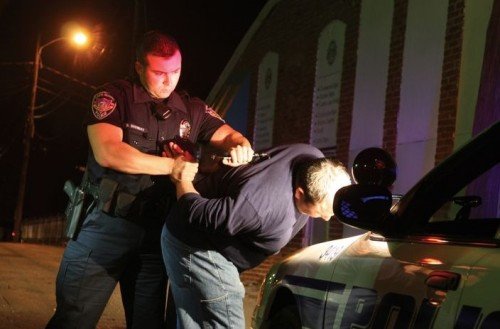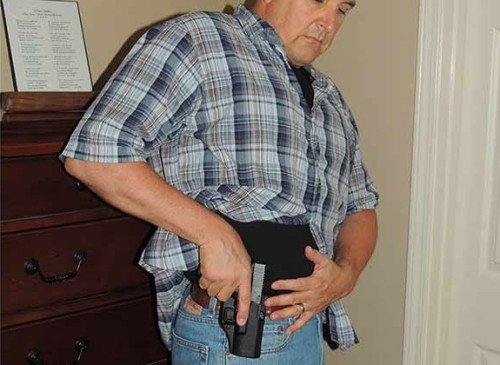A few weeks ago a suspect was arrested for Murder in Cleveland, Ohio. Officers transported him to the police station for an interrogation by detectives. Once at the police station he was led to a video recorded interrogation room where a uniformed officer was present to guard him. At one point someone off camera instructs the uniformed officer to remove the handcuffs from the suspect. The officer moves behind the suspect and begins to accomplish this task.
What happens next is one of the most horrific threats an officer can face – a motivated suspect grabbing for his handgun. Though seemingly implausible inside the police station, this act should stand as a strong reminder to officers that suspect control must remain a top priority even in areas considered relatively safe like the police station or Detention area.
Cleveland Police Gun Grab
As the video begins it is apparent the suspect has his left hand handcuffed to the chair he is sitting in, while his right hand is free. This securement method is often preferred in Detention areas and interrogation rooms, as it allows a right-handed person the ability to sign a Miranda Waiver or other types of booking information. However, leaving one hand free (particularly the suspect’s dominant hand) can be very problematic as this video shows.
The uniformed guard officer is seen walking in on the left of the screen for several seconds, before moving to the rear of the suspect after the apparent instruction from off-screen. As the officer begins to place handcuffs on the suspect, the suspect makes a target glance before making a sudden grab for the officer’s holstered sidearm.
(EDITOR’S NOTE: It is unclear, but appears the suspect already had a pair of handcuffs on his left hand. The suspect seems restricted with his left hand during the new handcuffing, and his wrist appears to be cuffed. It is possible he had been handcuffed to his pants or belt and the new cuffs were securing him to the chair).
Though fairly quick to respond to the attack, the uniformed officer is not able to grab the suspect until after the suspect has a hand on the officer’s sidearm. However, once the officer is able to react, his actions are nearly textbook in the proper methods to secure a holstered sidearm and fight-off a disarming attempt.
The officer places his right hand over the holstered firearm to keep the sidearm in its holster, while using his left arm in an attempt to leverage the suspect away from his handgun. The suspect is very committed and does not release the officer’s handgun even after being driven across the small room and into a wall. During the gun grab attempt he repeatedly yells, “kill me”, solidifying the The suspect only lets go of the officer’s sidearm after being subjected to the Taser. In the meantime the officer is in a fight of his life to keep the handgun from falling into the suspect’s control.
Thankfully two more nearby officers rush to the officer’s aid, and provide physical and then a Taser deployment assistance. The suspect is then quickly controlled and secured. Had the officer been alone, or backing officers not so close, there is a real danger this event could have ended more tragically.
Lessons Learned from Cleveland
The officers in this video handled themselves very well considering the life-threatening scenario that unfolded in seconds. The uniformed officer did an outstanding job of controlling his holstered sidearm during the surprise attack. However, there are just a few observations that could help prevent this scenario from happening in the future.
- Officer Safety Depends on You First!
The uniformed Cleveland officer did some outstanding weapon retention tactics, and ultimately prevented the suspect from obtaining his sidearm. However, the observations below might indicate some complacency on all of the officers present. Regardless of where you are, the responsibility to remain vigilant rests squarely on the shoulders of the individual officer.
In the video above the suspect had been apprehended after fleeing a vehicle stop in both his car and then on foot. This same suspect then fired on the pursuing Deputy striking him twice in the abdomen (non-fatally). Multiple police agencies were involved in the pursuit, and yet somehow the suspect was taken to the police station without being searched (or if he had, the search was woefully negligent). Just after sitting down, and getting a bottle of water, the suspect pulls out a Colt .45 from his waistband and shoots himself. Had he decided to shoot it out, several more officers would likely have been killed and wounded from this break-down in custodial techniques.
- Handcuffing
Though it is convenient to allow a suspect’s writing hand to be free for signing documents, this process could be limited to the actual signing times. Absent the need to sign something the suspect (here a murder suspect), could legitimately be secured in handcuffs. This could be behind their back, or in a proper front-facing belly-belt system. The later could even allow signing documents while still handcuffed. Simply handcuffing in the front (absent a belly-belt) is not sufficient has the suspect still has significant control of their arms and fists.
In this video two Minneapolis Transit officers are providing a “courtesy escort” to a male who was “obviously intoxicated” and harassing women at a downtown mall station. The officers claimed to have performed a frisk of the male prior to placing him into the patrol car. The frisk did produce a bottle of liquor, however a .38 caliber revolver was somehow missed. A “courtesy escort” will not legally justify handcuffing, but officers have every justification to frisk or request a full search before allowing a person into their vehicle.
This occurred during December, when heavier clothing is being worn. However, the only thing that prevented these two officers from being killed is the intoxication level of the male. He not only retrieved the hidden firearm from his waistband, he dropped it not once, but twice before the officers took action to stop a tragedy. Officers can not let their guard down when in the presence of potential suspects (this male was intoxicated, making him more than just a citizen to help).\
One of the most widely accepted custodial procedures in law enforcement is the concept of two officers to one suspect. I understand our rural brothers and sisters don’t always have that luxury, but when available this tactic should be utilized. Having two officers present gives a significant advantage to police while limiting the suspect’s options.
Proper contact and cover should be honored in the field unless other officers are present, but inside Detention or the police station a 2-officer handcuffing approach can used to further restrict the suspect. Here, there were other officers close by that could have been used to secure the suspect’s loose arm while handcuffs were removed or repositioned.
- Body Positioning
As the uniformed officer approaches the suspect he does a good job of covering his holstered sidearm, even if in the process of retrieving his handcuffs. He first places one cuff on the chair. However, once he begins to handcuff the suspect’s left hand he leans way over further exposing his firearm. Officers need to be constantly aware of where their sidearm is in relation to suspects, and take appropriate counter measures to lessen the availability for a gun grab.

In this situation, had the officer rotated his body counter-clockwise (to face the suspect) to complete the handcuffing, his sidearm would have been further away from the suspect (both behind and also away). Though this move would have potentially exposed the officer more to physical attack, the use of a second officer to control the suspect’s loose right arm would have nearly eliminated that potential.
- Recognizing Danger Clues
In a previous article on the Top 10 Deadly Errors of officers feloniously assaulted or killed in the line of duty, the FBI report indicated officers failed to recognize danger clues. In this incident, as soon as the officer begins his handcuffing procedure (inside of the police station) the suspect makes a quick target glance to his holstered handgun. While the second handcuff was being double-locked by the officer, the suspect makes a second target glance and then immediately grabs the officer’s handgun. Though the uniformed officer is occupied in handcuffing, he must remain aware of these clues and take immediate counter measures to stop them. The other officers, apparently just outside the open door, should also be watching and take action on any observed clues. This act by the suspect would likely have never happened had two officers been involved in handcuffing.
- Weapon Retention
The uniformed officer did an outstanding job retaining his holstered sidearm. Classic techniques of trapping the suspect’s hand on the grip/holster, while keeping a strong downward pressure to keep the firearm inside its holster was used. In addition, the officer used his support-hand to leverage the suspect off-balance to prevent a 2-handed grab or other types of attacks. Strikes to the suspect’s arm, face, head, or legs would all be justified uses of force in this encounter as well.
Weapon retention should be trained with the same frequency as handcuffing and other control techniques. Officers should do whatever they can to ensure they are using a high-quality and high-level security holster. The BlueSheepDog Crew does not recommend officers use any holster with less than two retention security features (Level II) while on duty, and recommend officers use at least a Level II holster off-duty as well.

- Proper Duty Holster
Having a proper security holster cannot be understated. The uniformed officer appears to be wearing a Safariland ALS light-bearing holster, providing excellent Level III protection.
Some of the most popular duty holsters in American law enforcement are the Safariland 070 SSIII, the Safariland 7TS ALS, and the Blackhawk Serpa. Each of these have a Level III (3 security features) retention capability and are outstanding holsters.
Officers should consider the holster a top-priority piece of equipment. If the agency does not provide equipment, or offers something less, the officer should at least try to secure approval for a Level III holster. At around $100-150 this will be one of the best purchases of your career.
Final Thoughts
As already stated, the Cleveland police officer performed very well once the attack began. His determined, and obviously trained, response prevented the suspect from being able to acquire his handgun. Though his counter-measures did not dislodge the suspect, they did place the suspect in an off-balanced position.
There were a few procedures that could have been implemented to reduce even the potential for this attack to occur. Officers should maintain officer safety protocols throughout contact with a suspect. Reviewing prisoner handcuffing, prisoner transporting, custody transfers, and interrogation room procedures can identify any deficiencies. And once procedures are in place, officers and supervision should be encouraged to review them to find any other ways they can be enhanced.
Do not let your guard down! No matter where you are, a motivated suspect will seek the slightest opportunity to assault you and escape. The most important part of countering an attack is you – a highly motivated, well-equipped, and physically fit police officer.